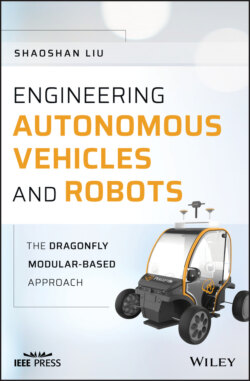Читать книгу Engineering Autonomous Vehicles and Robots - Shaoshan Liu - Страница 9
1 Affordable and Reliable Autonomous Driving Through Modular Design 1.1 Introduction
ОглавлениеIn recent years, autonomous driving has become quite a popular topic in the research community as well as in industry, and even in the press, but besides the fact that it is exciting and revolutionary, why should we deploy autonomous vehicles? One reason is that ridesharing using clean-energy autonomous vehicles will completely revolutionize the transportation industry by reducing pollution and traffic problems, by improving safety, and by making our economy more efficient.
More specifically and starting with pollution reduction: there are about 260 million cars in the US today. If we were to convert all cars to clean-energy cars, we would reduce annual carbon emissions by 800 million tons, which would account for 13.3% of the US commitment to the Paris Agreement [1]. Also, with near-perfect scheduling, if ridesharing autonomous vehicles could be deployed, the number of cars could be reduced by 75% [2]. Consequently, these two changes combined have the potential to yield an annual reduction of 1 billion tons in carbon emission, an amount roughly equivalent to 20% of the US Commitment to the Paris Agreement.
As for safety improvement, human drivers have a crash rate of 4.2 accidents per million miles (PMM), while the current autonomous vehicle crash rate is 3.2 crashes PMM [3]. Yet, as the safety of autonomous vehicles continues to improve, if the autonomous vehicle crash rate PMM can be made to drop below 1, a whopping 30 000 lives could be saved annually in the US alone [4].
Lastly, consider the impact on the economy. Each ton of carbon emission has around a $220 impact on the US GDP. This means that $220 B could be saved annually by converting all vehicles to ride-sharing clean-energy autonomous vehicles [5]. Also, since the average cost per crash is about $30 000 in the US, by dropping the autonomous vehicle crash rate PMM to below 1, we could achieve another annual cost reduction of $300 B [6]. Therefore, in the US alone, the universal adoption of ride-sharing clean-energy autonomous vehicles could save as much as $520 B annually, which almost ties with the GDP of Sweden, one of the world's largest economies.
Nonetheless, the large-scale adoption of autonomous driving vehicles is now meeting with several barriers, including reliability, ethical and legal considerations, and, not least of which, affordability. What are the problems behind the building and deploying of autonomous vehicles and how can we solve them? Answering these questions demands that we first look at the underlying design.
